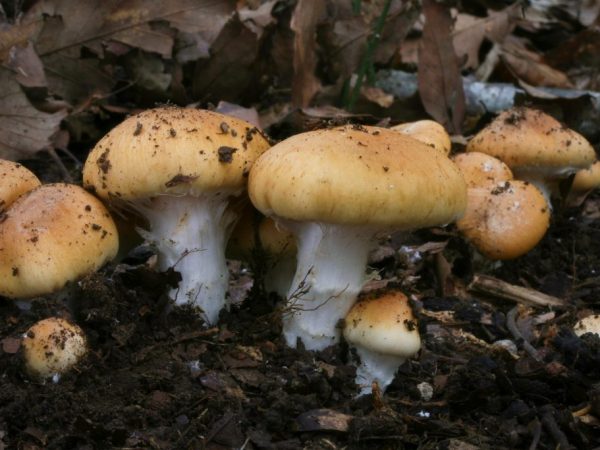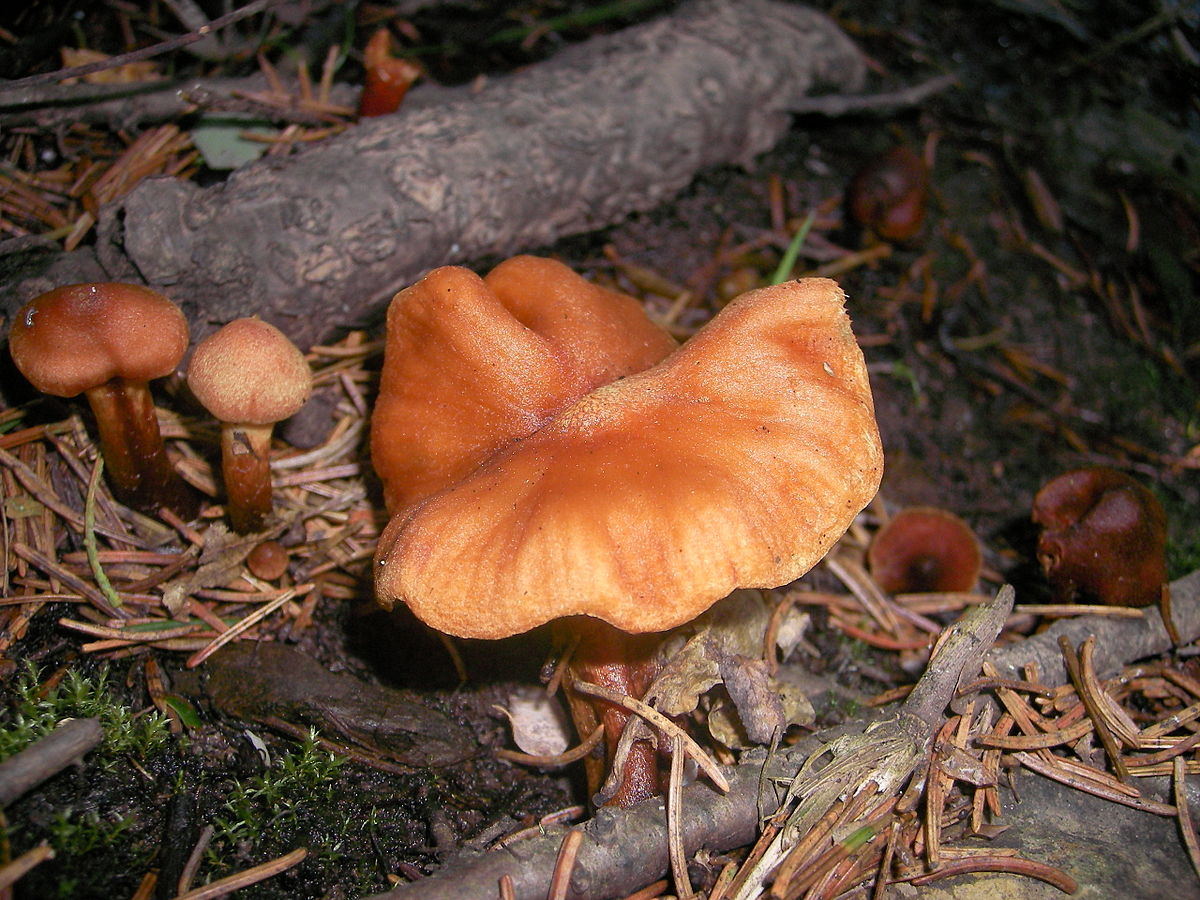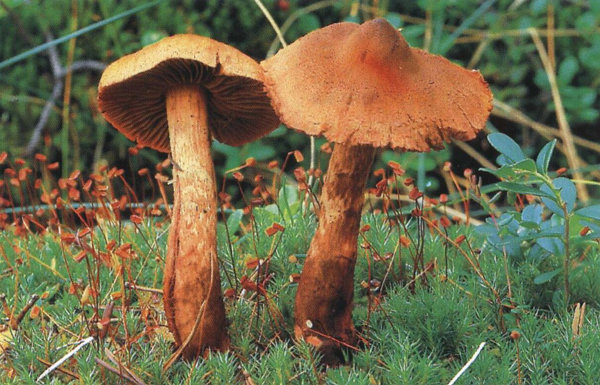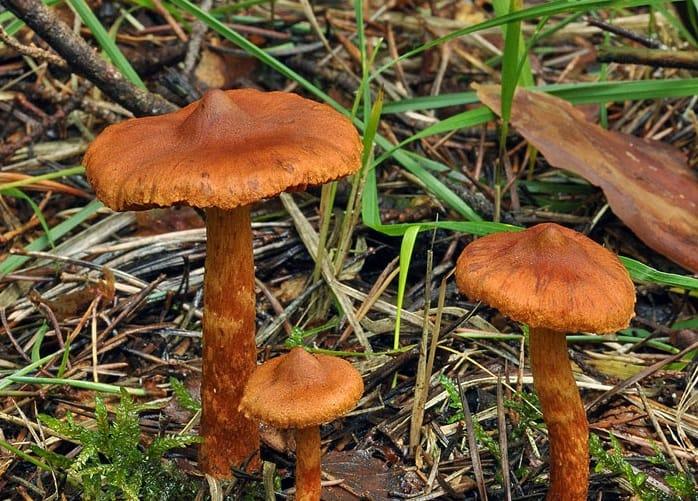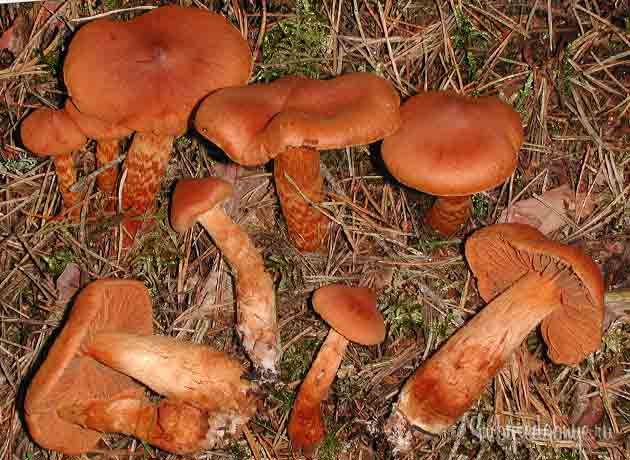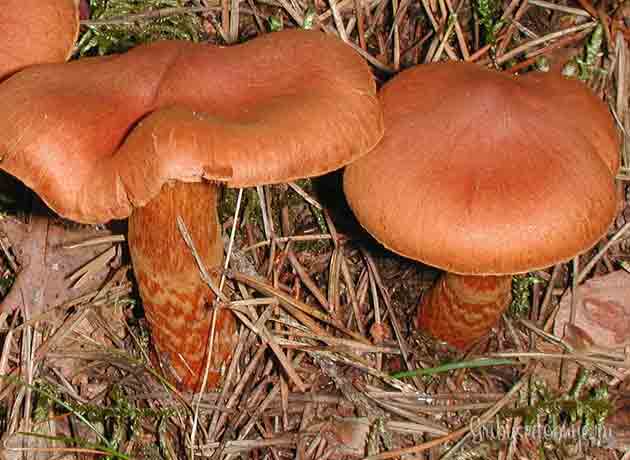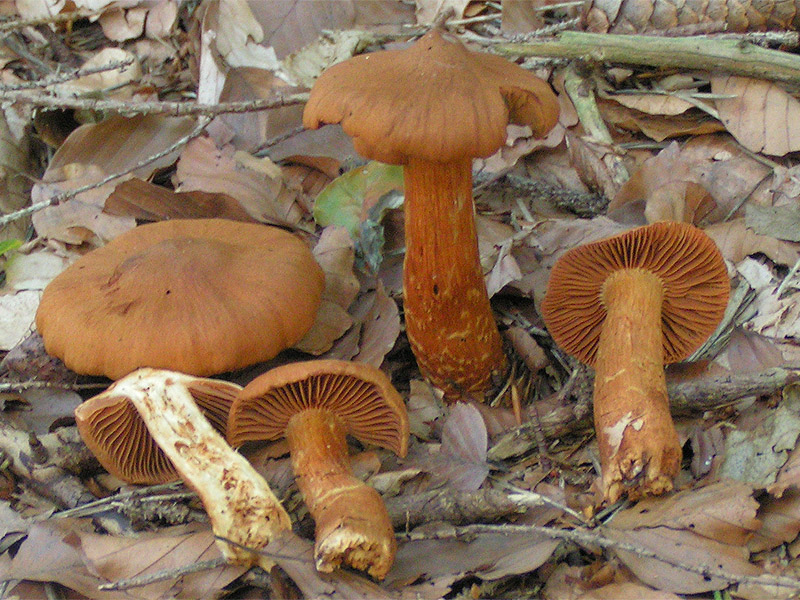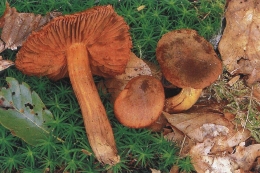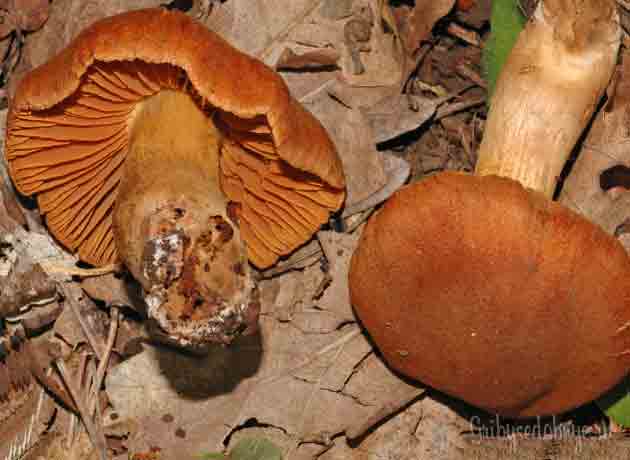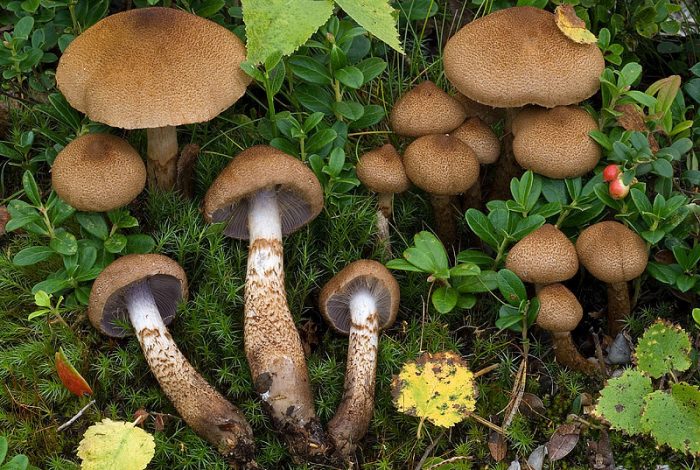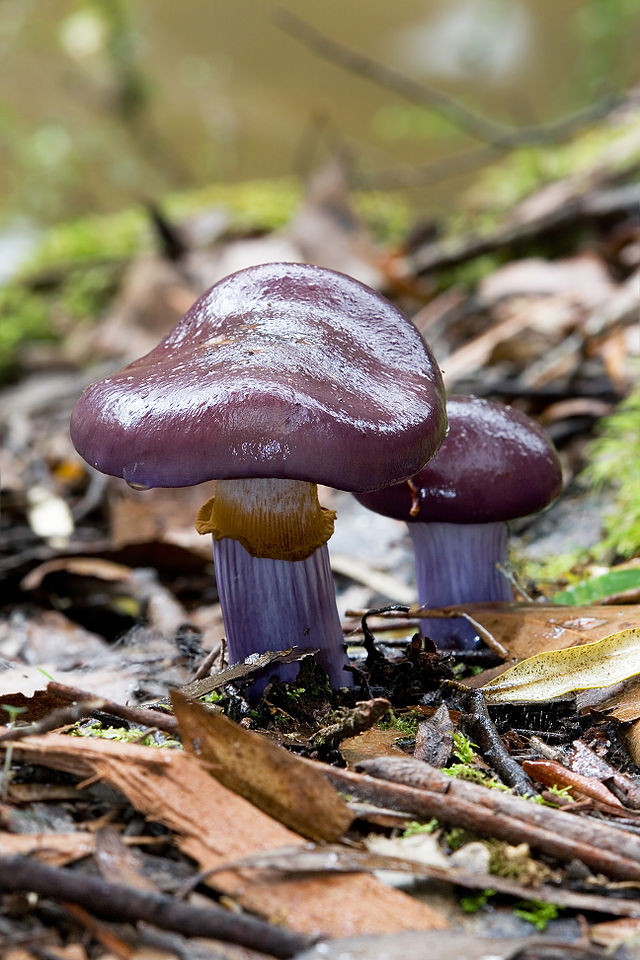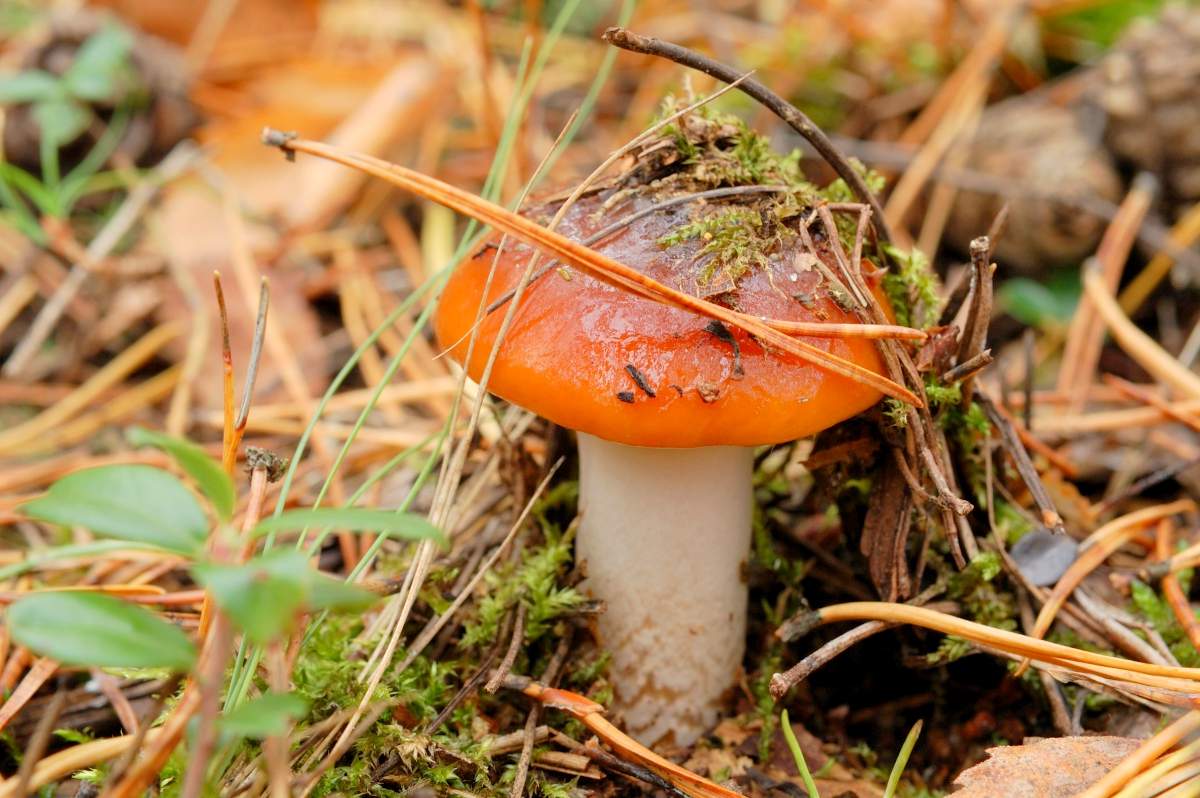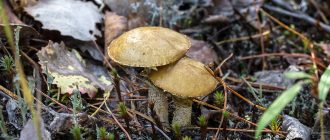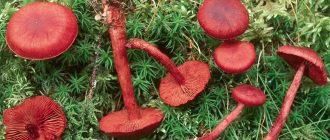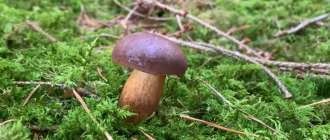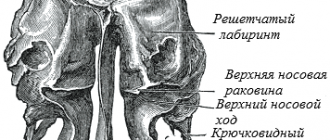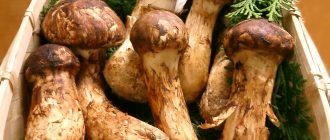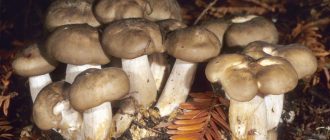Morphology
Fruiting bodies of various sizes, hats, have common and cobwebbed covers (cortina).
The cap is from hemispherical or conical to convex or flat, may have a pronounced tubercle, dry or slimy, with a smooth, fibrous (silky or felt) surface, sometimes scaly. The color is different: yellow or ocher, orange, brown, dark red, brown or purple, may fade with age.
The flesh in the cap is fleshy or relatively thin, white or colored: ocher, brown or yellow, less often bluish, purple or olive green. On the cut, the color may change.
The hymenophore is lamellar, the plates are adherent or weakly descending, thin, relatively frequent, less often thick, sparse. Colored can be varied.
The stem is cylindrical or clavate, often with a tuberous thickening at the base, usually of the same color as the cap, dry or slimy, fibrous, always with the remainder of the veil.
A private veil is usually preserved in mature fruiting bodies in the form of a cobweb ring in the upper part of the stem and cobwebs along the edge of the cap. A common veil can usually be seen only in young fruiting bodies; in mature ones, it rarely remains in the form of a cobweb bloom.
Spore powder of ocher and brown shades.
Mycorrhizal fungi are found in coniferous and deciduous forests.
Plush webcap (Cortinarius orellanus)
- Other names for the mushroom:
- Mountain webcap
- Cobweb orange-red
Other names:
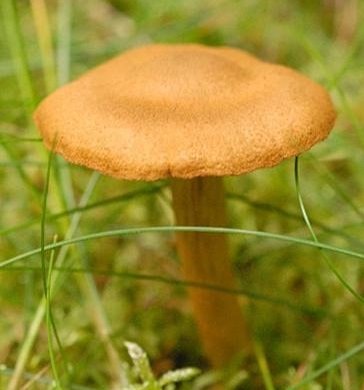 Description:
Description:
Teddy webcap (Cortinarius orellanus) has a dry, matte cap, covered with small scales, 3-8.5 cm in diameter, hemispherical at the beginning, then flat, with an expressionless tubercle, orange or brown-red with a golden tint. All of them are distinguished by non-slip, always dry fruiting bodies, a silky felt cap and a slender, not thickened leg. The plates are colored orange to rusty brown.
Distribution: The plush webcap is a relatively rare species. In some countries, it has not yet been found. In Europe, it grows mainly in autumn (sometimes at the end of summer) in deciduous, and occasionally in coniferous forests. It forms mycorrhiza mainly with oak and birch. Most often appears on acidic soils. Learning to recognize this extremely dangerous mushroom is very difficult, since there are many similar species; because of this, even for a specialist, it is not easy to determine a teddy webcap.
Note:
Plush webcap - deadly poisonous. Contains the poisonous substance orellanin, which causes pathological changes in the kidneys. Signs of poisoning appear 3-14 days after ingestion of the mushroom. The mushroom retains its toxic properties after boiling in water or drying.
Teddy webcap, like other types of cobwebs, until 1960 was considered a harmless mushroom. The prevailing opinion was that among the huge number of cobwebs (more than 400 species of them grow in Europe alone) there are only bitter inedible species and relatively tasty species that are suitable for writing.
However, after frequent poisoning that took place in Poland, many of which were fatal, it was possible to establish that the culprit was a plush spider web - a mushroom smelling of radish and a pleasant taste. During chemical analysis, several poisonous compounds were found in its fruits - orellanin, cortinarin, benzoinin, etc. days. Then there is a rapid deterioration in the human condition, impaired renal function and death.
In which regions is the mushroom listed in the Red Book
The ability of the pimple to form mycorrhiza with different trees gives him the opportunity to grow almost anywhere in the world.Despite this, the mushroom is quite rare, which is why it ended up on the pages of the Red Book in many regions of Russia.
The exotic variety is under protection in the Astrakhan, Vladimir, Vologda, Tambov, Yaroslavl, Novosibirsk, Oryol, Moscow, Murmansk and Leningrad regions. In addition, the mushroom received a special status in the Republic of Karelia, Komi, North Ossetia, Tatarstan, Khakassia, Altai Territory, Khanty-Mansi Autonomous Okrug and Chuvashia.
Definitioner
- Basidia (Basidia)
-
Lat. Basidia. A specialized structure of sexual reproduction in fungi, inherent only in Basidiomycetes. Basidia are terminal (end) elements of hyphae of various shapes and sizes, on which spores develop exogenously (outside).
Basidia are diverse in structure and method of attachment to hyphae.
According to the position relative to the axis of the hypha, to which they are attached, three types of basidia are distinguished:
Apical basidia are formed from the terminal cell of the hypha and are located parallel to its axis.
Pleurobasidia are formed from lateral processes and are located perpendicular to the axis of the hypha, which continues to grow and can form new processes with basidia.
Subasidia are formed from a lateral process, turned perpendicular to the axis of the hypha, which, after the formation of one basidium, stops its growth.
Based on morphology:
Holobasidia - unicellular basidia, not divided by septa (see Fig. A, D.).
Phragmobasidia are divided by transverse or vertical septa, usually into four cells (see Fig. B, C).
By type of development:
Heterobasidia consists of two parts - hypobasidia and epibasidia developing from it, with or without partitions (see Fig. C, B) (see Fig. D).
Homobasidia is not divided into hypo- and epibasidia and in all cases is considered holobasidia (Fig. A).
Basidia is the place of karyogamy, meiosis and the formation of basidiospores. Homobasidia, as a rule, is not functionally divided, and meiosis follows karyogamy in it. However, basidia can be divided into probasidia - the site of karyogamy and metabasidia - the site of meiosis. Probasidium is often a dormant spore, for example in rust fungi. In such cases, probazidia grows with metabasidia, in which meiosis occurs and on which basidiospores are formed (see Fig. E).
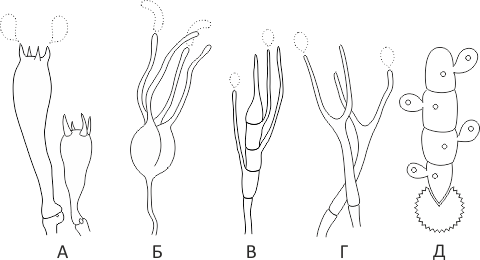
See Karyogamy, Meiosis, Gifa.
- Pileipellis
-
Lat. Pileipellis, skin - differentiated surface layer of the cap of agaricoid basidiomycetes. The structure of the skin in most cases differs from the inner flesh of the cap and may have a different structure. The structural features of pileipellis are often used as diagnostic features in descriptions of fungi species.
According to their structure, they are divided into four main types: cutis, trichoderma, hymeniderma and epithelium.
See Agaricoid fungi, Basidiomycete, Cutis, Trichoderma, Gimeniderm, Epithelium.
- Cutis
-
The type of cap skin, consists of creeping non-gelatinized hyphae located parallel to the surface. The surface of the cap looks smooth.
Lat. Cutis.
See Gifa.
Similar species
The most beautiful webcap can be confused with the dangerous and poisonous mountain webcap (Cortinarius orellanus). However, these two species can be distinguished by the rings on the leg - in the mountain, the remains of the bedspread in the form of red rims at the base are not visible. And it grows in deciduous forests near beeches and oaks.
Also, an inexperienced mushroom picker can easily confuse the hero of our article with a straight cobweb (Cortinarius collinitus). It does not smell like radishes and has a straight, light leg. This is an edible mushroom, and therefore you need to be very careful when collecting it - a mistake can cost you health.
In general, it is important to note that almost all cobwebs are easy to confuse with each other - they are very similar
What does a poisonous spiderweb mushroom look like (with photo)
The name spiderweb means a genus of mushrooms of the family of the same name. Among mushroom pickers, the popular name pribolotnik is quite common, which reflects the peculiarities of the growth of the fungus.The mushroom got its main name due to the fact that at the junction of the leg and the cap it has a kind of cobweb, which practically disappears as it grows.
We offer you to familiarize yourself with Imeretian saffron: composition, calorie content, the benefits of marigolds, recipes
Interestingly, in appearance, different types of spider webs differ quite strongly, and novice mushroom pickers can take them for completely different families. There are fruit bodies of both classical shape and mushrooms with spherical and conical caps. The surface can be either dry or slimy, with a smooth or scaly texture. The color of the hats is also quite varied: yellow, orange, brown-red, burgundy and even white-violet.
Cobwebs grow alone, but more often in families from 10 to 30 pieces. They should be looked for in the lowlands, and they are collected mainly at the end of summer and until the onset of the first autumn frosts (late October in the European part of the country and the second half of September in Siberia).
Cobweb lazy Cobweb lazy
Goat webcap Common webcap
Lazy webcap (Cortinarius bolaris)

Lazy webcap in the photo
The mushroom is inedible. Caps up to 3-8 cm, at first hemispherical, then convex and finally open, clay-yellow, densely covered with large red or red-orange scales. In young mushrooms, the scales are glued to the surface of the cap; the yellow color of the surface is visible only as small gaps between the red scales.
In mature mushrooms, the scales diverge along the surface of the cap and lag behind it at the edge. The plates are clay-yellow, then brown, turn red when damaged. Leg 5-7 cm long, 5-15 mm thick, cylindrical, reddish-fibrous, often scaly, like a cap. The pulp is whitish with a brownish tinge. Spore powder yellow-green.
Grows in deciduous, mixed and coniferous forests on acidic soil.
Fruiting from August to September.

Goat webcap (Cortinarius traganus)

The goat webcap grows very abundantly in deciduous and coniferous forests

Goat webcap in the photo
The mushroom is inedible. Massive caps 3–12 cm, at first, spherical and lilac, then hemispherical and, finally, open ocher, with a fringed edge. The plates are buffy-yellow with a violet tinge, later brownish-ocher. The leg is lilac or yellow, with scales, 5-10 cm long, 2-3 cm wide, with an extension at the bottom. The pulp of young mushrooms is white-blue, then ocher with an unpleasant "goat" smell of acetylene.
We suggest that you familiarize yourself with Cornelian cherry and barberry: the same or not, what is the difference, description of crops
The goat spider web has no poisonous counterparts.

Common webcap (Cortinarius triviah)

Common webcap in the photo
The edibility of the mushroom is questionable. Caps up to 5-8 cm, at first hemispherical, then convex or open, mucous yellow-rusty-brown, dry straw-yellow Plates are white-gray with a violet tinge, later rusty brown. Leg yellow or bluish, 8-12 cm long, 1-2 cm wide, covered with mucus in the upper part, with dark belts in the lower part. The pulp is light, whitish-buffy, in old mushrooms with a weak unpleasant odor.
It looks like an inedible slimy spider web (Cortinarius mucosus) with a white leg.


